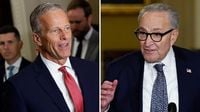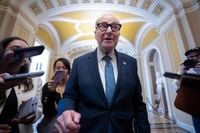As the clock struck midnight on October 1, 2025, the United States government officially entered its first shutdown in nearly seven years, plunging the nation into a fresh cycle of political brinkmanship and economic uncertainty. The impasse on Capitol Hill—rooted in a standoff over healthcare funding and Medicaid cuts—has left federal agencies scrambling, hundreds of thousands of federal workers facing furloughs or the threat of layoffs, and the American public watching as partisan blame games unfold across both traditional media and social platforms.
The drama reached its crescendo late Tuesday night, when the Senate failed to pass both a Republican-backed stopgap bill and a Democratic counterproposal. The Republican measure, which would have extended government funding for seven weeks, fell short of the 60-vote threshold required to overcome a filibuster, with a 55-45 result. The Democratic bill, which aimed to extend health care subsidies under the Affordable Care Act and reverse recent Medicaid cuts, also failed to garner enough support. According to CBC News, the outcome triggered the first government shutdown since the end of 2018, when a similar funding lapse lasted a record 35 days during President Donald Trump’s first term.
In the hours leading up to the shutdown, the White House Office of Management and Budget instructed federal agencies to prepare their plans for an “orderly shutdown.” The Congressional Budget Office estimated that around 750,000 federal workers could be furloughed each day the government remains closed. Essential personnel—including air traffic controllers, airport security officers, and some military members—will continue working, but without pay until the shutdown ends. The Trump administration has threatened that the shutdown could mean not just furloughs, but also mass layoffs for some federal workers, a move that has sparked anxiety among government employees and their families.
The battle lines on Capitol Hill were drawn sharply. President Trump and Republican leaders placed the blame squarely on Democrats, arguing that their insistence on extending Obamacare subsidies and reversing Medicaid cuts derailed any chance at a bipartisan agreement. “Democrats have officially voted to CLOSE the government. Results: Moms and kids now lose WIC nutrition. Veterans lose health care and suicide prevention programs. FEMA has shortfalls during hurricane season. Soldiers and TSA agents go UNPAID. The only question now: How long will Chuck Schumer let this pain go on—for his own selfish reasons?” Speaker Mike Johnson wrote on X (formerly Twitter), capturing the Republican messaging strategy as reported by Deadline.
Democrats, on the other hand, accused Republicans—and President Trump in particular—of stonewalling negotiations and using the threat of a shutdown to force through unpopular policy choices. Senate Minority Leader Chuck Schumer and House Minority Leader Hakeem Jeffries released a joint statement just after midnight, declaring, “After months of making life harder and more expensive, Donald Trump and Republicans have now shut down the federal government because they do not want to protect the healthcare of the American people. Democrats remain ready to find a bipartisan path forward to reopen the government in a way that lowers costs and addresses the Republican healthcare crisis. But we need a credible partner.”
Healthcare has remained at the heart of the dispute. Democrats have demanded immediate negotiations to extend expanded Affordable Care Act tax credits, which are set to expire at the end of the year. Millions of Americans who purchase health insurance through the ACA could face higher premiums as a result. They also called for the reversal of Medicaid cuts enacted as part of what President Trump called his “big, beautiful bill” earlier this summer, and for assurances that the White House wouldn’t rescind already-passed Congressional spending. “We are not going to support a partisan Republican spending bill that continues to gut the health care of everyday Americans,” Jeffries said, as cited by CBC News.
Republicans, who hold a 53-47 majority in the Senate, argued that their funding bill was a “clean” measure that should have been noncontroversial. Senate Majority Leader John Thune insisted, “We can reopen it tomorrow,” if enough Democrats break party lines, and maintained that Republicans were open to negotiating on the ACA issue—but only after the government was kept open. Some Democrats and an Independent did cross party lines to vote with Republicans, but not enough to overcome the filibuster.
The political messaging war has raged far beyond the Senate floor. On social media, prominent Democrats including Vice President Kamala Harris and California Governor Gavin Newsom pointed fingers at Trump and the Republican Party. Harris posted, “Let me be clear: Republicans are in charge of the White House, House, and Senate. This is their shutdown.” Newsom echoed the sentiment, writing, “Donald Trump just shut down the government.” President Trump, meanwhile, took to social media with a series of doctored videos mocking Democratic leaders, including a widely shared deepfake of Schumer and Jeffries that critics called racist and juvenile. “Mr. President, the next time you have something to say about me, don’t cop out through a racist and fake AI video,” Jeffries responded, according to Deadline.
In the midst of the partisan warfare, federal workers are bracing for the worst. Many have faced shutdowns before, and while some express resignation, the threat of layoffs rather than temporary furloughs has introduced a new level of anxiety. The White House has instructed agencies to consider “a reduction in force” for many programs, meaning that some workers could lose their jobs permanently if the shutdown drags on. “Instead of fighting Trump we’re actually empowering him, which is what finally drove my decision,” Independent Senator Angus King said, reflecting the difficult choices facing lawmakers.
The consequences of the shutdown extend far beyond Washington. Programs such as WIC nutrition assistance, veterans’ healthcare, and FEMA disaster relief face immediate disruptions. Congressional staffers—many of whom will continue working without pay—hope for retroactive compensation but face uncertainty. The last shutdown in 2018-2019 saw disruptions to everything from airport security to national park operations, and this time, the stakes are just as high.
Both parties have signaled that the shutdown could be resolved quickly—if the other side blinks. Thune predicted Democratic support for the Republican bill would increase “when they realize that this is playing a losing hand.” But Democrats remain adamant that they will not back down in the face of what they call Republican intransigence and threats to essential healthcare programs. As Senator Peter Welch put it, “The level of appeasement that Trump demands never ends. So is there a point where you just have to stand up to him? I think there is.”
For now, the nation waits. With the government shuttered and both sides digging in, federal workers and millions of Americans are left in limbo, hoping that cooler heads will ultimately prevail and restore a sense of normalcy in Washington.



